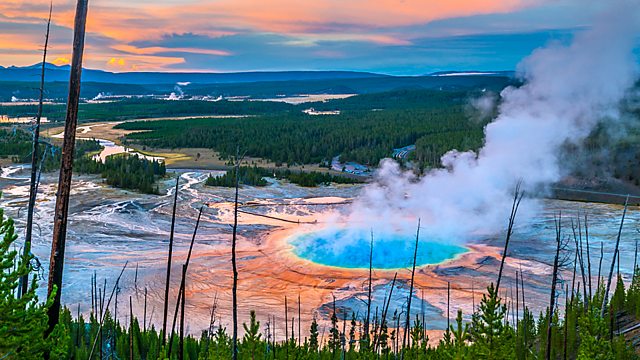پادکست انگلیسی BBC – محیط اکستروفیلی
در پادکست انگلیسی BBC – محیط اکستروفیلی ، درمورد محیط های اکستروفیلی صحبت میشه.افزایش مطالعه میکروب های اکستروفیلی در مورد آنچه که هست و برای ادامه حیات در زمین مورد نیاز نیست ، چیزهای زیادی را نشان داد. همچنین تئوری های جدیدی درباره چگونگی و زمان آغاز زندگی ایجاد شده است. نیل و آلیس در مورد محیط های اکستروفیلی و اینکه چگونه این ها با مکان های مورد علاقه خود متفاوت است بحث میکنند.
سوال پادکست انگلیسی BBC – محیط اکستروفیلی :
Which have extremophiles living in them? Is it…
a) Grand Canyon?
b) Death Valley National Park?
c) Yellowstone?
به پادکست خوب گوش کن تا جواب رو پیدا کنی.
اگر می خوای گوش دادن به پادکست تا حد امکان برات ساده و کارآمد باشه مراحل زیر را دنبال کن:
هر روز به پادکست گوش کن. وقتی براش یه وقت ثابت در روز در نظر بگیری برات تبدیل به عادت میشه و این عادت هرروز پیشرفت میکنه.
پادکستی رو پیدا کن که موضوعش برات جالب باشه. وقتی از خود موضوع لذت ببری یادگیری هم برات لذتبخش میشه.
به پادکستی گوش کن که transcript یا متن داره. این بهت کمک می کنه تا کلمات و عبارات جدید رو به سرعت در متن پیدا کنی و ساختار انواع مختلف جمله رو خوب یاد بگیری.
پس از گوش دادن به پادکست با متن، در مرحله بعدی سعی کن بدون نگاه کردن به متن این کار رو انجام بدی. این کار مهارت شنیداری رو تقویت می کنه و کمک می کنه تا انگلیسی زبانان بومی را راحت تر درک کنی، حتی اگر خیلی سریع صحبت کنن.
اگه به پادکست انگلیسی گوش کردی و نتونستی کامل متوجه اش بشی، ناامید نشو. پادکست هایESL -English as Second Language بیشماری وجود دارن که برای سطوح مختلف، از ابتدایی تا پیشرفته طراحی شدن. مطمئنا هر روز می تونین یه پادکست مناسب با سطح خودت پیدا کنی.
فراموش نکن که هرچی بیشتر تمرین کنی در اون مهارت رشد میکنی! به قول انگلیسی ها: Practice makes perfect
واژگان کلیدی پادکست انگلیسی BBC - محیط اکستروفیلی
| معنی به فارسی | معنی به انگلیسی | واژه |
| میکروارگانیسم هایی که سازگار شده اند تا بتوانند در شرایط زندگی شدید زندگی کنند | microorganisms that have adapted to live in what we would consider to be extreme conditions | extremophiles |
| خصومت آمیز | unfriendly | hostile |
| چشمه های آب گرم که آب گرم و بخار را به هوا شلیک میکنند | hot springs that shoot hot water and steam into the air | geysers |
| میکروارگانیسمها | really tiny life forms that can only be seen with a microscope | microorganisms |
| گیاه شناسی | the study of plants | botany |
| جانور شناسی | the study of animals | zoology |
| باستان | a group of single-celled microbes similar to bacteria but different to all other known types | archaea |
| ارگانیسم چند سلولی - و شامل حیوانات ، گیاهان و قارچ ها می شود | a multicellular organism– and includes animals, plants, and fungi | eukaryote |
| پر رونق | doing well | thriving |
| دریچه های حرارتی | holes in the ocean floor from which flow mineral-rich superheated water from the Earth's crust | hydrothermal vents |
BBC 6 minute English -Life on the edge?

برای دانلود پادکست روی سه نقطه سمت راست کلیک و گزینه Download را انتخاب کنید.
متن پادکست انگلیسی BBC - محیط اکستروفیلی
Alice
Hello and welcome to 6 Minute English. I'm Alice…
Neil
And I'm Neil. So Alice, what's your ideal place to be?
Alice
Curled up on the sofa with a good book in front of a log fire. Last night it was very cold.
Neil
Well, for me, lying in a hammock under a palm tree on a tropical beach with a cool breeze. I don't like when it's too hot.
Alice
Yes, true. Humans don't cope well with extremes of temperature but some species do. The subject of today's show is extremophiles – these are microorganisms that have adapted to live in what we would consider to be extreme conditions. For example, living in near boiling acidic water or frozen at the bottom of an Antarctic lake.
Neil
Those do sound like pretty extreme conditions.
Alice
Yes. The thing is, what sounds hostile – or unfriendly – to us, are perfect environments for extremophiles and in fact they wouldn't survive without them. Now, are you tough enough to face up to today's quiz question, Neil?
Neil
I think so.
Alice
Alright then, here goes: which US National Park is home to geysers – or hot springs that shoot hot water and steam into the air – which have extremophiles living in them? Is it…
a) Grand Canyon?
b) Death Valley National Park?
Or c) Yellowstone?
Neil
That's easy - it has to be c) Yellowstone.
Alice
OK, well we'll find out if you got the answer right later on in the show. But, moving on, now, Neil, did you know that extremophiles belong to an entirely different group of living things to other animals and plants?
Neil
No. I imagined extremophiles would be like insects, because insects are pretty tough, aren't they?
Alice
Yes, that's true. But remember, extremophiles are microorganisms – they're really tiny. Let's listen to Ian Crawford, Professor of Planetary Science and Astrobiology at Birkbeck University of London. He tells us how in the 1970s a scientist called Carl Woese identified a new kingdom of living things that he called 'archaea' – meaning 'ancient ones'. The extremophiles belong to this group.
INSERT
Ian Crawford, Professor of Planetary Science and Astrobiology at Birkbeck University of London
Well, the old tree of life idea basically talked about empires if you like, of plants, and animals, and things that we can see, essentially. We put a great deal of emphasis on large organisms and the traditional distinction in biology between botany and zoology. What it really did was say 'that's all wrong – there's really only three major groups in life: there's the archaea, the bacteria, and the eukaryotes, which is all of this complex life'; and so it kind of put humans into a small corner of the tree of life next to plants and whatever else. It kind of squashes us again after being the centre of the universe.
Neil
So botany is the study of plant life, and zoology is the study of animal life. But maybe you can explain 'archaea', and 'eukaryotes', Alice.
Alice
Archaea are a group of single-celled microbes similar to bacteria but different to all other known types. Eukaryote is the scientific term for organisms with a much larger and more complex type of cell– and this group includes all animals, plants, and fungi.
Neil
But why are archaea so important? Why do they need a whole biological domain to themselves, while we humans get squashed up in one domain with plants and fungi?
Alice
Well, Neil, it's likely they've have been living on our planet ever since the Earth became habitable – and that's billions of years. And they are still living and thriving in a whole range of different environments today.
Neil
And when something is thriving it means it's doing well! So tell us about where they live, Alice.
Alice
Some live in hydrothermal vents – holes in the ocean floor hundreds of metres down where there's lots of pressure and no sunlight. And mineral-rich superheated water is coming out of the Earth's crust and then flowing out through these holes.
Neil
I see… Well, what about cold-loving extremophiles?
Alice
Well, scientists have found them in hidden lakes trapped beneath ice sheets hundreds of metres thick in Antarctica. It takes days to drill through the ice to reach the water.
Neil
And how do they survive down there?
Alice
Well, these microbes have found a way of getting energy from certain minerals like iron and sulphur present in the water.
Neil
That sounds clever for a microbe – how did they figure that out?
Alice
It isn't a question of cleverness - it's a question of adaptation. Extremophiles are extremely well adapted to their environment and they appeared on Earth much earlier than more complex life forms. Let's hear from Nick Lane, Reader in Evolutionary Biochemistry at University College London.
INSERT
Nick Lane, Reader in Evolutionary Biochemistry at University College London
The origin of the Eukaryotic cell, it seems to have happened once, it took about 2 billion years before that happened. Then there was kind of a great leap forward at the cellular level, but another billion years went by before we see animals.
Neil
So, basically, the animal kingdom is much newer than the archaean kingdom.
Alice
Indeed. And now it's time for the answer to today's quiz question, Neil. I asked: which US National Park is home to geysers that have extremophiles living in them? Is it… a) Grand Canyon, b) Death Valley National Park or c) Yellowstone?
Neil
And I said c) Yellowstone. I must be right.
Alice
Yes, Neil, you are right - it's Yellowstone National Park. Every year, scientists discover remarkable new microbes in Yellowstone's hot springs, with implications for medicine, agriculture and energy, as well as offering clues to the formation of the earliest life on Earth.
Neil
Very interesting. Now, here are the words we heard today:
extremophiles
hostile
geysers
microorganisms
botany
zoology
archaea
eukaryote
thriving
hydrothermal vents
Alice
And that's the end of today's 6 Minute English. Don't forget to join us again soon!
Both
Bye!
امیدوارم از پادکست انگلیسی BBC - محیط اکستروفیلی لذت برده باشید.
گوش دادن به پادکست روش خوبی برای تقویت مهارت شنیداری و هم چنین یادگرفتن کلمات در بستر یک موضوع خاصه که این به تقویت مهارت مکالمه انگلیسی نیز کمک زیادی می کنه.
اگه تو هم از اون آدمهایی هستی که از گوش دادن به پادکست لذت می بره برات یه خبر خوب دارم! آموزشگاه زبان انگلیسی 24talk یه دوره طراحی کرده مبتنی بر پادکست و داستان کوتاه به اسم "پادکستوری - Podcastory". این دوره سعی کرده یادگیری زبان انگلیسی رو مناسب با نیاز و سطح زبان آموز به یه فرایند بسیار مفرح، موثر، سریع و کم هزینه تبدیل کنه.
همین الان می تونی با کلیک روی عکس زیر و ثبت نام در دوره ی آموزش زبان انگلیسی با پادکست و داستان ۲۴talk اولین و مهم ترین قدم رو برای یادگیری زبان انگلیسی برداری. وقت رو از دست نده!
دوره پادکستوری آکادمی مجازی 24talk
برای شنیدن دیگر پادکست ها، به بخش پادکست در مرکز آموزش رایگان مراجعه نمایید.








